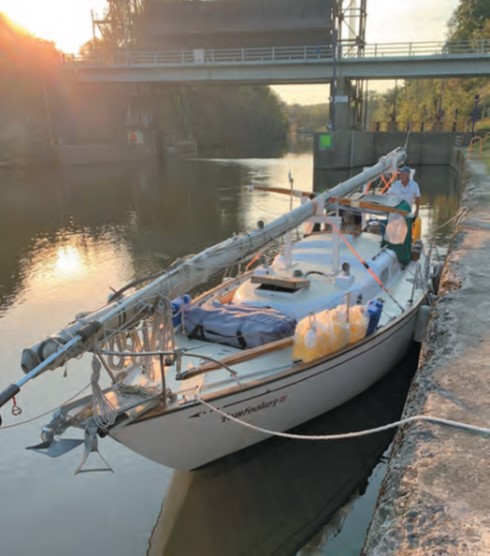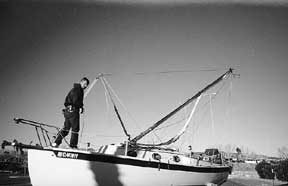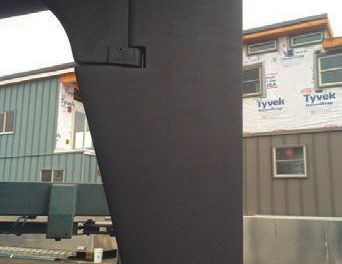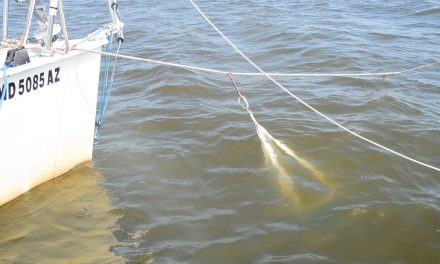A clever design for storable mast supports makes for easy traveling between lakes.
Issue 142: Jan/Feb 2022
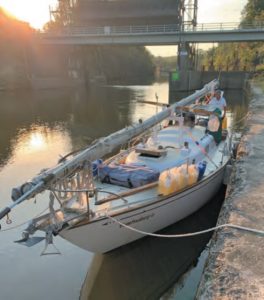
Tomfoolery canal-side with her mast down and lashed to the supports.
I have the great fortune to live next to an inland lake that is fully navigable, which means that I can go literally anywhere in the world from my home port. But there’s one catch if I want to venture forth: I must unstep the mast so my 1965 Alberg 35, Tomfoolery, will fit under bridges and other structures in the New York Canal system.
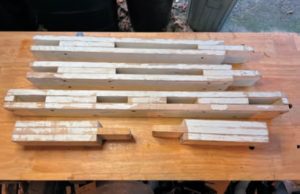
Disassembled, the mast supports are easy to bundle together and store aboard. Note the gaps cut out of the center pieces of the laminate; two 1 x 4s are strong enough to support Tom’s mast, so he cut out portions of the third, center piece to save lumber and weight. The gaps also provide a convenient place to pass through straps and lashings when tying down the mast.
No big deal, right? Slap some 2 x 4s together to make mast crutches and off we go. And for a time, that’s what I did, and the supports worked great and were inexpensive to build. But they were bulky and difficult to store and transport.
When we would travel to Lake Ontario and the Thousand Islands from the Finger Lakes, I would have to finesse them into my car to get them to the boat. Once on the boat they were fine, but when we would step the mast after leaving the canals, I had to store them ashore while we cruised the larger lake, and then fetch them again before our return trip in the canals. This meant we always had to return to the same spot to retrieve the supports.
What would be ideal, I thought, would be a set of supports that could be folded up and stowed without taking up too much space. Being an engineer, I couldn’t resist the temptation to design something to meet these requirements.
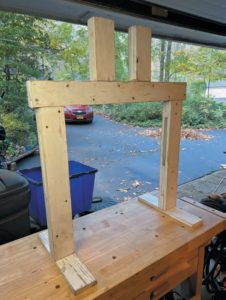
One of the supports fully assembled. The mast sits securely between the top two vertical chocks.
With spreaders, shrouds, running rigging, and other fixtures, my mast weighs about 300 pounds. I would only need two supports since the bow pulpit would hold the mast up forward. I developed a design that uses mortise-and-tenon joinery and the weight of the mast to hold things together; it requires no mechanical fasteners, only some lines and tie-downs to secure the whole assembly to the boat. It also allows the supports to be taken apart and stowed in a cockpit locker without consuming much volume.

The aft support weighs about 22 pounds and is just under 6 feet tall, making the mast high enough to clear the dodger and provide for headroom for the crew in the cockpit. The small vertical chocks help hold the mast in position on each cross piece.
Both supports follow the same design; they consist of two vertical columns and a horizontal beam. The columns attach to feet that let the support stand securely. Two vertical chocks that fit into the horizontal beam provide a cradle for the mast and prevent it from rolling to one side or the other before everything is secured. The length of the horizontal beam is determined by the usable width of the deck where I planned to place the supports; for this calculation, I had to pay attention to the locations of cleats, vents, deck penetrations, and opening hatches.
I made each column and beam of the supports by laminating three layers of 1 x 4 pine lumber (these can be joined with screws and/or glue). Then, I created mortise-and-tenon joints by leaving the center piece longer than the two sides, so it sticks out (the tenon), and cutting a chunk out of the center piece to create a gap (the mortice). This simple method eliminated the need to drill, cut, and shape each joint.
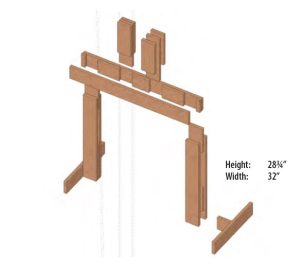
The mid support weighs about 13 pounds and is about 2 feet tall. It’s narrow enough that it fits between two Dorades on the coach roof.
Another design factor was storing the mast at a height sufficient to provide standing headroom in the cockpit and to clear the dodger so that it could be left up. This way, I could also rig a tarp or awning over the mast and tie it to the supports to provide a full cockpit cover for really sunny or rainy days.
It was easy enough to calculate this height for the middle support; I tied a piece of string to the bow pulpit, pulled it taut, and then raised it high enough to clear everything. Then I had a helper measure the distance from the deck where the support would stand up to the string, and subtracted 3-½ inches (the width of the 1 x 4 in the support’s cross beam). I did the same thing to calculate the aft support’s height, this time taking the string to the location and height of where the middle support would be, then pulling it aft over the cockpit and accounting for standing headroom and the dodger.
To date, these crutches have made four transits of the Erie Canal. I’ve also used them to support the mast while the boat was in storage for one upstate New York winter, and they held up a considerable amount of snow on the tarp draped over the boat without allowing the mast to sag. So far, they have lived up to my expectations, and I look forward to many more years of service from them.
Tom Alley and his family sail a 1965 Alberg 35 sloop, Tomfoolery, and are active racers and cruisers with the Finger Lakes Yacht Club in Watkins Glen, New York. He also manages the Alberg 35 User Group website (Alberg35.org). When he’s not sailing, thinking about sailing, or tinkering with his boat, Tom is either scuba diving, hanging out with fellow amateur radio operators, or (as a last resort) working as an engineer to support his sailing addiction and, if there’s any money left over, send his kids to college.
Thank you to Sailrite Enterprises, Inc., for providing free access to back issues of Good Old Boat through intellectual property rights. Sailrite.com

